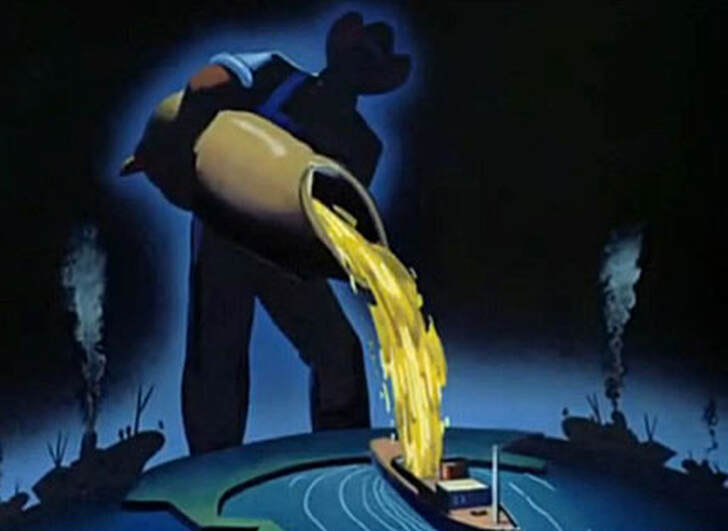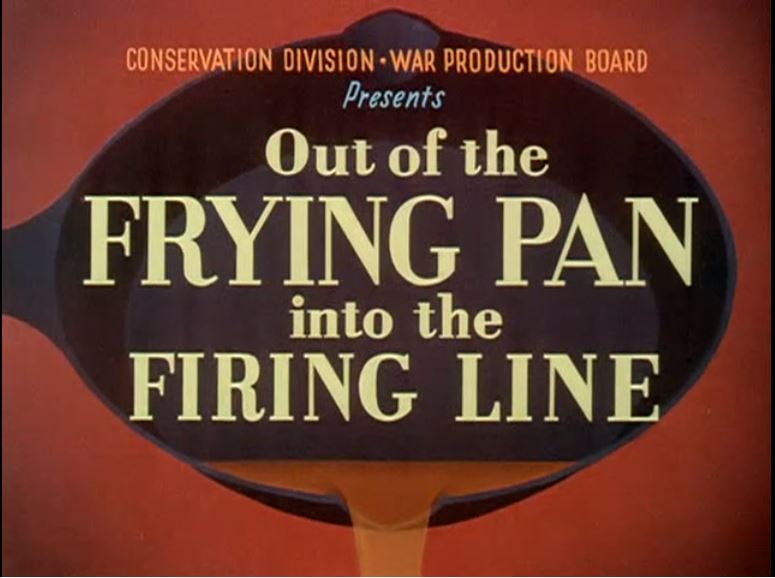|
We get to visit Disney in World War II again this week! In this charming little film, "Out of the Frying Pan, Into the Firing Line," first released in July of 1942, we see familiar characters Minnie Mouse and Pluto learning about the role of kitchen fats in munitions manufacturing.
The little films opens with Minnie frying up a pound of bacon on the stove, and then offering to pour the hot grease over Pluto's bowl of dog biscuits, much to his delight. But an authoritative voice from over the radio interrupts, telling of the value of saving kitchen fats for use in the manufacture of glycerin, a primary ingredient in explosives.
Although Pluto starts out angry at being denied the delicious bacon grease, a reminder that waste fats give soldiers more ammunition, with a quick pan over to the photo of Mickey Mouse in his soldier's uniform, convinces him otherwise. A quick salute to Mickey and Pluto is ready to help Minnie save the fats. He even brings the can of fat to the butcher in exchange for a string of hot dogs. This adorable little film, which was likely geared towards children as well as adults, helped convince Americans to alter their usual behaviors in the home and contribute to the war effort by saving every scrape of waste fats possible. To learn more about Disney in World War II, check out our previous post.
The Food Historian blog is supported by patrons on Patreon! Patrons help keep blog posts like this one free and available to the public. Join us for awesome members-only content like free digitized cookbooks from my personal collection, e-newsletter, and even snail mail from time to time!
1 Comment
 “Who’s afraid of the big bad wolf, not the farmer of the United States who works and sacrifices to fill the holds of victory ships…,” says the narrator as an oversized silhouetted farmer pours grain into the hold of a ship. Still from the film "Food Will Win the War" (1942). Courtesy Cartoonresearch.com Previously, we met Jack Sprat and his wife in a fairytale cartoon propaganda poster. This week, we go all out total war with Walt Disney. Produced by Disney in 1942, "Food Will Win the War" was a propaganda film of the Agricultural Marketing Administration, under the auspices of the United States Department of Agriculture. Narrated like a newsreel, the cartoon illustrates the might of American agriculture, in brilliant technicolor. The cartoon illustrations of the overwhelming productivity of American agriculture compare mind-boggling production numbers to well-known landmarks and other Very Large Things. Flour to blizzards, bread to the Egyptian pyramids, tomatoes to the Rock of Gibraltar, cheese to the moon, etc. When getting to meat production, we get to see the Disney's Three Little Pigs, leading a parade of hundreds of hogs, playing "Who's Afraid of the Big, Bad Wolf?" on fife and drum. Periodically, we are reminded that the size of several of these items could crush Berlin, including a very plump blonde representing American fat and oil production. One scene compares American agriculture to a giant bowling ball, which is depicted rolling through Nazi headquarters (tattering the Nazi flag in the process), and bowling over pins caricaturing Adolf Hitler, Benito Mussolini, and Emperor Hirohito. The film closes with a grim montage of the challenges faced by shipping and a call to the Four Freedoms outlined by FDR - Freedom of Speech, Freedom of Religion, Freedom from Want, and Freedom from Fear. Like many propaganda films and newsreels from World War II, this one has plenty of bombast, with good and evil portrayed in stark black and white terms (even though the animation is in color). Released to American audiences on July 21, 1942, it had several goals. One was to buoy American confidence in food supplies. There were concerns that the U.S. was shipping too much produce overseas and that there would be shortages at home. These concerns were not unfounded, but wartime production increased enough that even though rationing eventually grew tight, everyone had enough to eat. Another was to impress upon foreign audiences that American production capacity was overwhelming and would strengthen the Allies, who had been at war for over two years already. In 1941, Disney was suffering major financial losses from Fantasia - it was a box office flop and made just a fraction of what it cost to produce. You can see the economy of animation in many of the scenes of this film - where largely still images move across the frame or zoom in or out - achieved by layering cells. But the success of Disney's animated films for the war effort helped keep the studio afloat during the war. They became well-known in particular for training films, as Disney animators were able to illustrate in fine detail mechanical operations and theoretical scenarios that would be difficult or impossible to film in real life. Some speculate that without World War II, Disney Studios might have gone under after only a few films. The Food Historian blog is supported by patrons on Patreon! Patrons help keep blog posts like this one free and available to the public. Join us for awesome members-only content like free digitized cookbooks from my personal collection, e-newsletter, and even snail mail from time to time! |
AuthorSarah Wassberg Johnson has an MA in Public History from the University at Albany and studies early 20th century food history. Archives
July 2024
Categories
All
|


 RSS Feed
RSS Feed